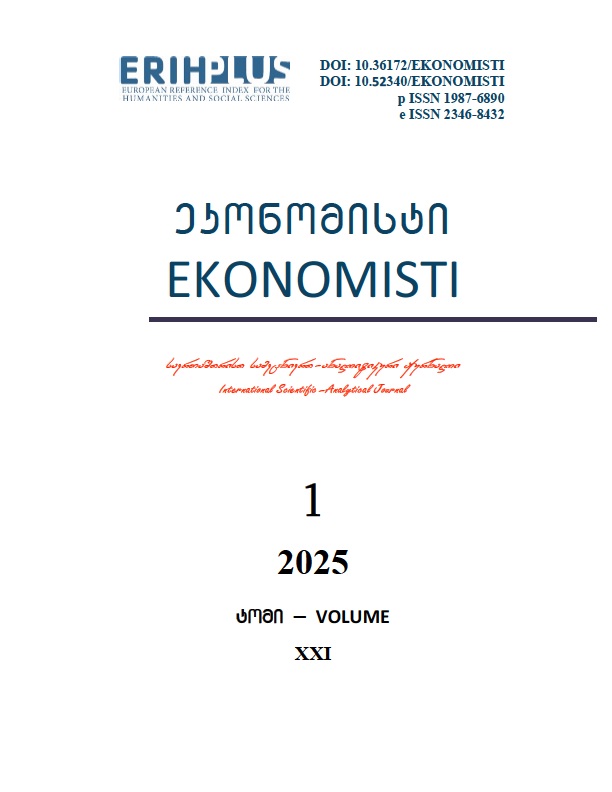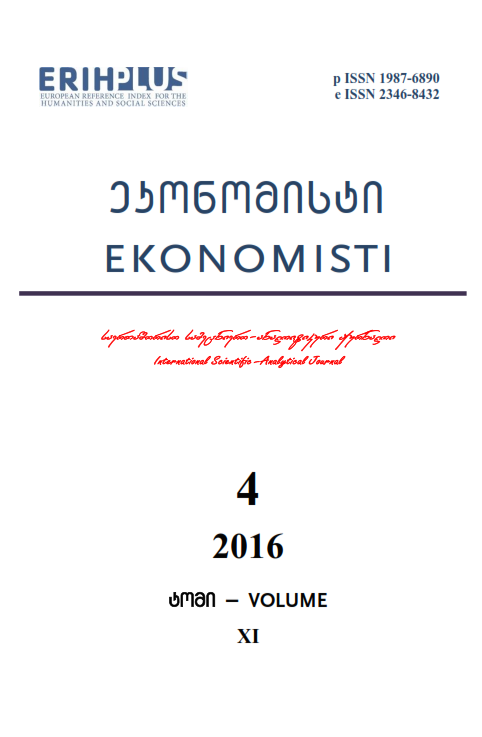
The international scientific and analytical, reviewed, printing and electronic journal of Paata Gugushvili Institute of Economics of Ivane Javakhishvili Tbilisi State University

APPLICATION OF COMPARATIVE ANALYSIS OF OFFICIAL POLLS AND EXPERT ESTIMATIONS OF INDICATORS IN DEMOGRAPHIC PROJECTIONS
Summary
Projections are generally based on official demographic polls of national statistics. The projections (especially in developing countries) that are based on inexact statistical information of expected natural movement and migration of the population have often some inaccuracies.
In this regard, we argue that is preferably to have an evidence based expert assessment as an alternative measure to the official census while doing projections.
Considering the example of Georgian census 2014, it can be said that expert assessments were more accurate. This means that in case of inexact projections, comparative analysis of official statistics and experts assessments will ensure enhanced and more accurate projections.
Key words: demographic statistic, evaluative data, birth rate, mortality rate, indicator of migration.
Introduction
During review of current demographic processes in Georgia, besides analysis of official statistical data, the evaluation method is used, which often differs from official statistical data. The official statistical data analysis leads to the conclusion that the demo-statistical data do not always reflect the real situation, since cases of demographic reports was not and is not fully conducted.
In addition, the analysis revealed that the inaccurate registration of demographic reports, does not constitute the phenomenon of relatively new, post-soviet period. It existed in post-soviet times and within possibility, inaccurate demographic registrations were identified since 1960 [Anderson, Katus, Silver 1994: 10-11; Anderson, Silver 1986: 712].
Inaccurate registration of demographic reports were characteristic of previous period, thus the problem of inaccurate demo-statistical registration will be discussed since 1960.
Problems of inaccurate registration generally is and was related to registration of death, however, in some period, an inaccurate registration also affected birth registration, but international migration in terms of accounting is in the worst condition.
Thus in this paper, differences between official and comparative analysis of demographic processes since 1960 year are presented.
Methodology of research
Accuracy of number of population and age composition is mainly depended on current complete registration of birth, death and international migration.
In 1990, known political, social, economic and public events caused deterioration of registration of demographic data and migration, as a result it made difficult to determine population age-sex structure and number of population. Based on the above with official statistics appeared unofficial statistics, in the scientific calculations, the data significantly differs from indicators and data of Georgian National statistics office.
During evaluation of demo-statistic data, based on the development of appropriate models for the moment, there was used demographic, epidemiological and migratory transition theories, Cole indexes. UN experts, foreign and Georgian Scientists calculations, determinant analysis of affecting factors of demographic processes, as well as some of the traces of the Institute of Demography and sociology demo-sociological studies and etc. [Tsiklauri, Sulaberidze, 2013: 7; World Population Prospects: the 2012 Revision: 2013].
Unlike us, National statistics office, do not have a right to recalculate and assess current official statistical information given by official offices. Because of this, National Statistics Offices gives collective data of the information provided by official offices which inaccurately shows demographic situation.
Difference between official and estimated demo-static data
Based on proper analysis we estimated that number of population counted during population census made in 1970 as well as In 1979, 1989, 2002 and 2014 does not fit number of population of natural movement and emigration between periods of census [Tsuladze, Sulaberidze, Maglaperidze, Mamardashvili, 2008: 114-131]. The scale of the study period, and the quantity of the article, in order to highlight the issue, consider two periods from 1960 to 2000 and since 2000.
a) 1960-2000
Reason of the Difference the number of population calculated by National center of statistic and by us, is inaccurate registration of natural movement and migration. According to UN experts, in 1960-1965 years 20 thousand dead person remained unrecorded, while part of the inaccurate registration was 40%. The latter was quite high, but lower than indicators of former soviet republics of Central Asia.
As UN experts, as well as our evaluation shows that during discussed period (1960-2000 years) there was an incomplete registration of deaths. According to UN experts, incomplete registration of deaths was higher than our estimations showed. In 1960-1990 years incomplete registration of death in Georgia in overall was: according to UN expert estimation – 125 thousand (15.4%), according to our estimations – 165 thousand (12.2%).
In 1990 years, Statistical agencies (as well as many other agencies) meet unprepared to political, social-economic and public changes, which caused deterioration of statistical registration of death as well as other demographic reports. In 1990 years level of incomplete registration of death increased compared to 1980 and 1970 years.
It is remarkable that, results of population registration in 2002, caused recalculation of demographic indicators of periods between census (1989 and 2002 years), among this recalculation of number of death.
National center of statistic’s data of number of death was different before and after recalculation. Their recalculated data about number of death, despite of some differences, is similar to our estimated data. According to data before recalculation, in 1990-2000 years, in Georgia died 460,9 thousand person, and according to recalculated data died – 552,6 thousand. At this time, according to our estimated data, died 560,2 thousand.
Estimated analysis of death rate data of 1960-2000 years, in contrast to the data of the same time of national statistic center, gives the reason to understand newly, as the evolution of life expectancy, as well as the general demographic transition in Georgia [Anderson, Katus, Silver 1994: 10-11; Anderson, Silver 1986: 712].
Georgia is among the countries, in which international migration plays an important role in the formation of the population. The point is that the emigration since 1960 is characterized by a negative balance.
Unlike to National Statistic Center data, estimated data for the period of 1960-2000 years, as a result of emigration, the population of Georgia reduced by more than 1404 thousand person.
The most important for Georgian was 1990 years, when according to different estimated data, as a result of international migration of population is much more damaged, rather than the previous 30-year period.
According to estimated data in 1990-2000 years, as a result of negative balance of emigration, Georgia has suffered a 19% loss of population of 1989 year, this means that almost every fifth person has left the country.
Thus, we can make the conclusion that over the 1960-2000 period, official data on the number of population, including the census, was inaccurate and unreliable. During Population census, the total population was excessive (except 1979 year).
Foresee of incomplete accounting of the dead and out-migration of total population, in 1960-2000 years, according to our estimates, is different from the number of population of Georgian, which is provided by National statistic center of Georgia(before recalculation).
The figure below gives a clear picture 1.
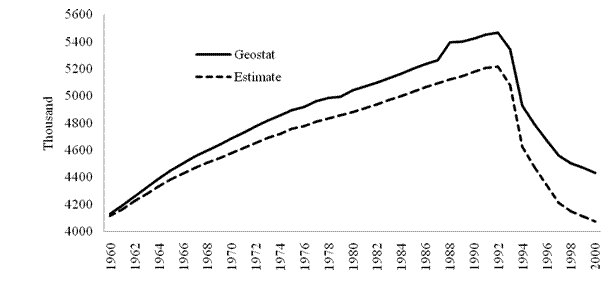
Figure 1. Number of population according to Geostat and our estimations (thousand) 1960-2000 [Tsuladze... 2008: 7-15]
As we can see, difference between our estimations of number of population and national statistic centers estimation increases since 1960 year. In 1970 year his difference was 107 thousand, in 1980 year – 157 thousand, in 1990 year – 236 thousand, and in 2000 – 1028 thousand. So, according to our estimation number of population of Georgian in 1960-2000 years was always less, compared to data of department of statistics. With this, according to out estimations, since 1992 year number of population of Georgia decreases, while according to department of statistic there is an increase of number of population in Georgia.
The figure 1 clearly shows that in 1960-1991 years in Georgia, although a variety of size, but the population growth has taken place, which since 1992 has changed the decrease. Number of population of Georgia in 1960-1991 years increased by 1099 thousand, and in 1992-2000 years decreased by 882 thousand. In total population increase natural and mechanical movement (migration) had different part (see figure 2).

Figure 2. Components of increase (decrease) of population in Georgia 1960-2000 years. (Thousands) Net-migration: 1960-1989 (Geostat); 1990-2000 (our estimation); Natural increase-our estimated data [Tsuladze... 2008: 61-68; Tsuladze, 2015: 47-48, 317; Population of Georgia. Statistical collection, 2003: 67].
During discussed period of time even though there was reduction of natural increase and it reduced to zero point, its’ importance was positive while balance of emigration was negative.
Before 1992 year balance of natural increase was higher compared to negative net-migration, this was the reason of general increase in population of Georgia. From 1992 year, On the one hand, the sharp decline in natural growth, and on the other hand, increase of out-migration, in the following years led to a significant decrease of the population.
Thus, the main component of quantitative formation of population of Georgia was natural growth in 1960-1991 years, and international migration in 1991-2000 years.
b) 2000-2014
When we are discussing 2000 years, first of all remarkable is population census made in 2002 year. Its results are evaluated differently by specialists.
First of all this critical attitude is based on census papers of immigrants, which did not work or worked bad. For example, the 2002 census shows that the number of emigrants from Georgia is 113.7 thousand [First National Census Results of Georgian Population in 2002, 2003:]. The same time the Department of Statistics estimated the negative net-migration, for the period of time before and after census, was approximately 930 thousand [Population of Georgia. Statistical collection, 2003: 67].
2002 census results show that the permanent population was 4371,5 thousand, while the actual population was 4355,7 thousand, difference between them was 15,8 thousand.
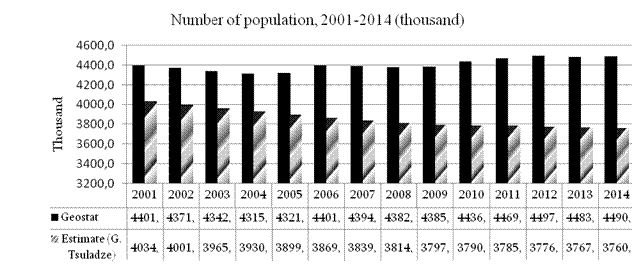
Figure 3. Change of population of Georgia 2000-2014 (1st January). [Tsuladze... 2008: 68-69; Tsuladze, 2015: 17]
Figure shows, that in 2002, number of evaluated population was 370.5 thousand compared to constant population. In 2003-2014 this difference was growing and for 1st January of 2014 year it reached 729,8 thousand, i.e. 16,3%. At the same time, the population is 4 million according to the data of the National Statistics Office and from 2008 year it is characterized by tendency of growth. In contrast, the evaluation data from 2002 it is below 4 million and has a reduction tendency. From two components of formation, in case of Geostat net-migration does not have any negative role, in contrast, according to data evaluation, key factor of change in number of population, mostly is international migration, which is clearly shown by the figure 4.
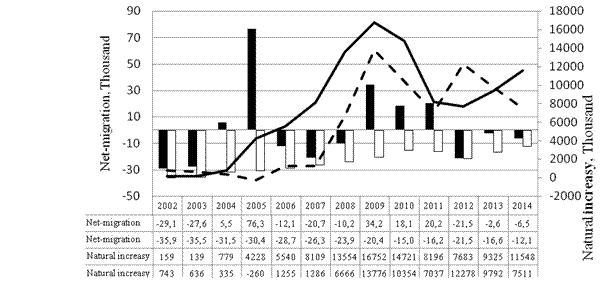
Figure4. Total population increase (decrease) components in Georgia 2001-2014. (Thousand) [Tsuladze, 2015: 47-48, 317]
Reason of such contrasting difference between National Statistic office and evaluative indicators is problem of demo-statistic census of population. it is reasonable to compare and analyze separately, as components of natural increase, number of death and birth, as well as migration balance according to our and National Statistic office indicators.

Figure 5. The dynamics of the number of birth in 2000-2014 [Tsuladze, 2015: 48]
This figure 5 shows that, in 2007-2009 years, according to National Statistic Office and our estimation number of birth is similar, which demonstrates improvement of registration system during these years. In contrast to these years, difference in previous and following years demonstrates the incomplete registration of birth. 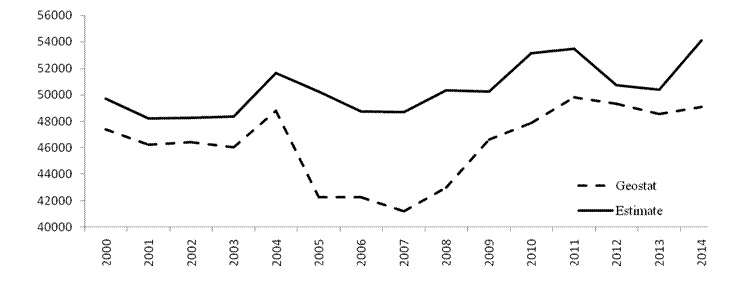 Figure 6. The dynamics of the number of deaths in 2000-2014 [Tsuladze, 2015: 48]
Figure 6. The dynamics of the number of deaths in 2000-2014 [Tsuladze, 2015: 48]
Unlike the recording of live births, in the period 2000-2014 accounting of death is more violated, particularly in the years 2004-2010, which is clearly shown in figure 6.
From dynamics of birth and death, in 2002-2014 natural growth data according to National Statistic Office was 100,000 person, while estimations showed that it was 71.4 thousand person.
As figure 7 shows, compared to accounting of population natural movement components, accounting of international migration is in rather bad situation. in 2002-2014 years, net-migration, because of incorrect accounting, according to national Statistic office data was positive and it was 24 thousand, while according to estimations it was negative and its was -314 thousand person.
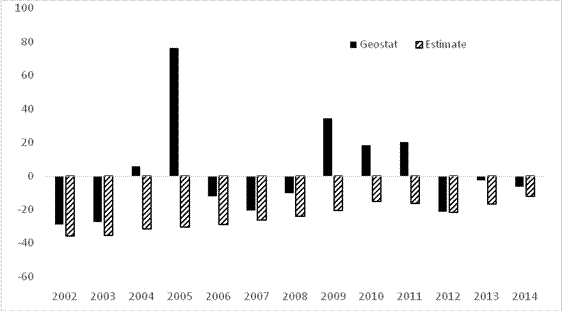
Figure 7. Net-migration of population of Georgia in 2002-2014 years [Tsuladze... 2008: 103-106; Tsuladze, 2015: 317]
As we mentioned in methodology of research, National Statistic Office is not legally entitled to make verification of current statistical information obtained officially from state offices. As a result, in official statistics, children born outside the maternity hospital, in apartments, and in case of death (especially in infants) funerals of bypassing registration are not recorded.
The point is that, as our and UN experts researches of different years show, in Georgia, especially in the mountains and in villages of Kvemo Kartli home deliveries are still frequent. In addition part of the Azerbaijanis living in Georgia are giving birth in Azerbaijan. Before Georgia-Russia war in 2008, during peaceful relationship between Ossetians and Georgians, population living near Tskhinvali region were going to Tskhinvali for childbirth. This was mainly due to the difficult socio-economic situation in Georgia and expensive childbirth in Georgia. This part is not registered and therefore not recorded in the National Statistic Office indicators of collective birth rate.
Problem of death accounting is complicated by the fact that some of the villages and regions often don’t ask the certificate of death registration for the burial ground. In addition, because of socio-economic conditions of family, in order to maintain pension of deceased, sometimes families don’t make registration of death or makes registration of death lately or etc.
Unlike to natural movement of the population, mainly reason of the inaccurate accounting of migration is wrong methodology. In particular, Border Defense Department registered only visitors, and because of lack of the statistical bases it was not possible to separate duration and other parameters, which would allow National Statistical office to account international migration properly. From 2012 year new methodology of international migration accounting developed by National Statistic Office significantly reduced inaccurate accounting of emigration and we hope it will improve. As for internal migration, generally collapsed after the Soviet period, movement of population much inside the country is no longer controlled and therefore no longer enrolled.
Table the level of incomplete accounting of population (%) in components of natural movement and in international migration indicators of National Statistic Office in 2002-2014
|
Live births |
Death |
Infant mortality |
Net-migration |
|
|
2002 |
5,1 |
4,0 |
- |
23,4 |
|
2003 |
6,1 |
5,0 |
5,0 |
28,6 |
|
2004 |
5,0 |
5,8 |
5,2 |
672,7 |
|
2005 |
7,5 |
18,8 |
25,5 |
1398,5 |
|
2006 |
4,6 |
15,4 |
52,7 |
137,2 |
|
2007 |
1,5 |
18,3 |
67,7 |
27,1 |
|
2008 |
0,8 |
17,0 |
23,3 |
134,2 |
|
2009 |
1,0 |
7,7 |
37,4 |
1600,0 |
|
2010 |
1,5 |
11,0 |
85,4 |
1828,8 |
|
2011 |
4,2 |
7,3 |
70,7 |
1802,0 |
|
2012 |
10,5 |
2,8 |
68,0 |
0.0 |
|
2013 |
4,0 |
3,8 |
64,0 |
84,3 |
|
2014 |
1,6 |
10,2 |
64,3 |
86,2 |
Based on the above, as table shows, during last 2 period between censuses, according to differences between National Statistic Office and our estimations, level of inaccurate registration of birth was lower (2010) in some years, while in case of deceased persons it was high (except 2012). Compared to them, quite high level of inaccurate accounting of infant mortality level, significantly increases, expected life of population in time of birth, which, according to evaluation index, in contrast to National Statistic Office index, is lower. unlike to accounting of natural movement of population, inaccurate accounting level of emigration is very high, which in 2005,14 times, 16 times in 2009, 2010 and 2011 and 18 times higher than the actual level.
Difference between our and National Statistic Office estimations of annual difference between the number of population is not surprise anymore between two period between censuses of 2002-2014 years. According to figure 4, population of Georgia for 1st January of 2015 year must have been 4496 thousand person, but 2014 census showed that population was 3730 thousand, 766 thousand less (-17%). In this regard, the experts' estimations indicators were much more accurate, which states that by January 1, 2015 the population is projected to be 3768 persons and actually amounted 3756. Difference is only 2000 person (0,1%).
National Statistic offices’, period between censuses 2002-2014, even one, restated demographic data of 2014 year gives significant changes. If According to the National Statistic office’s 2013 birth rate was 12,9‰ and 16.3‰ respectively in 2014, instead of the 13,5‰. It is same in case of death rate. If according to National Statistic office in 2013 death rate was 12,9‰, in 2014 it was 13.2‰ instead of 10.9‰. Difference 2.3‰ is quite high.
In this aspect, indicators of life expectancy at birth is interesting. II these indicators according to National Statistic office data for both sex in 2013 was 75,2 year, in 2014 calculations it is 72,9 year, 2,3 years less. With this, in one year, for men it reduced by 2,1 year and it was 68,7 year, and for women it reduced by 2,2 year and it is 77,2 year.
Conclusion
Thus, the 2014 census confirmed in conditions of inaccurate accounting unreliability of official statistics. Because of this based projections are wrong. Therefore, while predicting the demographic projections, it is desirable, if not feasible, the calculation of expert estimations of alternative projections on the local level. For example, as the population of the various points of the forecast is based on official statistics in the wrong demographic features, so unlike the Georgian experts (G. Tsuladze) in estimations rates for 2015 the forecast is much closer to the recorded number of 2014 population census. in particular for 2015 year population of Georgian according to UN projections must have been – 4225 thousand, World Bank – 4078 thousand, Bureau of USA population census – 4525 thousand, and according to G. Tsuladze estimations projections 3905 thousand, which is much more closer to the actual indicator of number of population [Tsuladze, 2013: 35].
References
-
Anderson B.A., Katus K., and Silver B.D., 1994, Developments and Prospects for Population Statistics in Countries of the Former Soviet Union. Population Index 60(1): 4-20.
-
Doi: 10.2307/3645322.Anderson B.A. & Silver B.D., 1986, Infant mortality in the Soviet Union: Regional differences and measurement issues. Population and Developments Review 12(4): 705-738. Doi: 10.2307/19734332.
- Anderson B.A. & Silver B.D., 1989, The Changing Shape of Soviet Mortality, 1958-1985: An Evaluation of Old and New Evidence. Population Studies 43(2): 243-265.
Doi: 10.1080/0032472031000144106. - Geostat, 2003, First National Census Results of Georgian Population in 2002, part 1: Tbilisi, Georgia.
- Demo-sociologic research materials of Institute Of Demography and Sociology of Ilia State University. 2014.
- First National Census Results of Georgian Population in 2002, part 1: Tbilisi, Georgia.
- http://esa.un.org; http://web.worldbank.org; www.census.gov; World Population Prospects: The 2010 Revision; http://esa.un.org/unpd/wpp/index.htm
- Gomelauri N., 2014, Alternative forms of family and out-of-wedlock births. Problems of demography and sociology. Collection. Tbilisi, pp. 76-87.
- Population of Georgia, 2003, Statistical collection. Department of Statistics in Georgia. Tbilisi, pg. 67.
- 10. Sulaberidze A., 2008, Distorted Migration Terms: Cui Bono?Journal of Social, Political and Economic Studies. Institute of Strategic Studies of the Caucasus. The Caucasus Globalization. Volume 2. Issue 1. CA&CC Press. Sweden. p. 82.
- Tsiklauri Sh. & Sulaberidze A.V., 2013, Qualitative and methodological aspects of population projections in Georgia. Georgian Population Prospects: 1950-2050. EUROSTAT international symposium “Demographic projections”. Rome. Italy. http://www.unece.org/fileadmin/DAM/Stats/documents/ece/ge.11./2013/wp7.1.pdf
- Tsuladze G., Sulaberidze A., Maglaperidze N. & Mamardashvili G., 2008, Demographic Development of Georgia: Yesterday, Today, Tomorrow. Tbilisi.
- Tsuladze G., 2015, Demographic Yearbook of Georgia 2014. UNFPA. Tbilisi,
- Population Situation Analysis (PSA). Georgia http://www.demographic-research.org/Volumes/Vol22/23
- Tsuladze G., 2013, Demographic perspectives of Georgia. Tbilisi, pg. 35.
- United Nations, 2013, World Population Prospects: the 2012 Revision. New York, United Nations Population Division, UNDESA.
